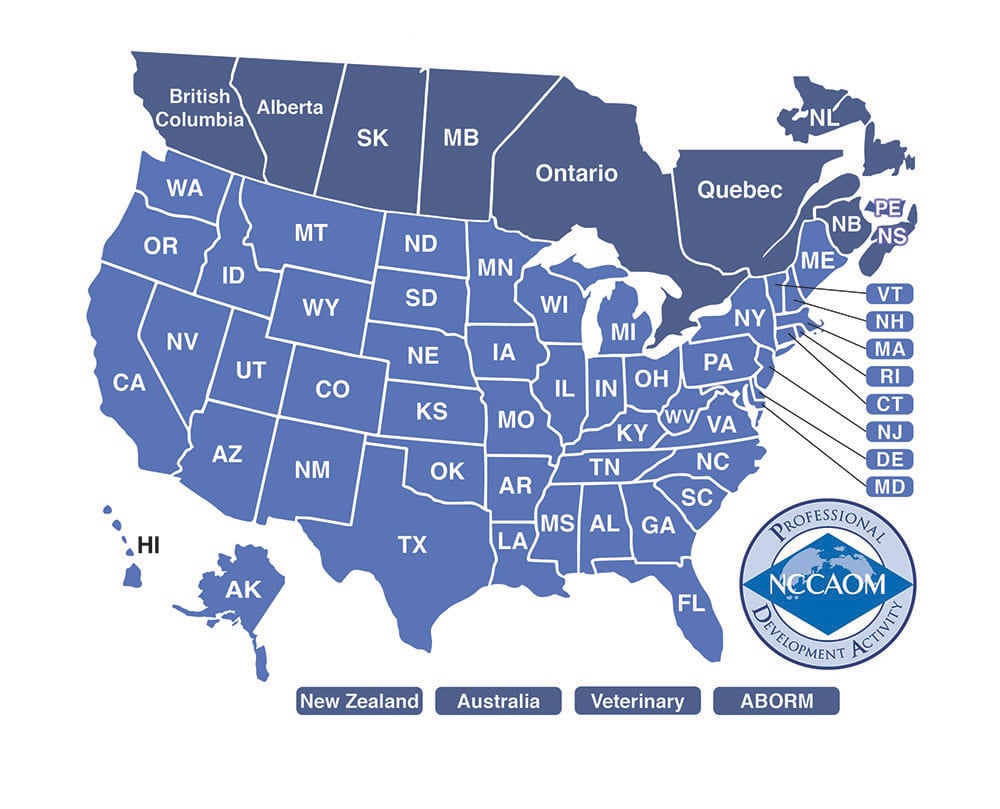Safety In Acupuncture
Pneumothorax Prevention #1
Samples of Course Materials
Authors: Colleen DeLaney, L.Ac., M.T.C.M. and John Struthers, L.Ac.
Introduction section excerpt:
Acupuncture & Pneumothorax
I. Introduction
Acupuncture, when performed by a licensed acupuncturist, is safe and effective. Creating a pneumothorax (collapsed lung) through performing acupuncture is an avoidable risk. This can be avoided with a thorough understanding of lung anatomy in relationship to acupuncture points. This course will give an overview of underlying anatomy and give safe needling techniques so that the licensed acupuncture professional need never risk causing a pneumothorax.
II. Definition and Mechanism of Pneumothorax
Pneumothorax is defined as the presence of air or gas within the pleural space, the "potential" space between the chest wall and the lung. A compete explanation of the how this causes pneumothorax is presented below.
Between the lungs and the chest wall are two layers of pleural lining, the visceral pleura and the parietal pleura, normally without any space between them. These two layers slide smoothly across each other due to serous fluid within the pleural space.
The function of the pleural space is to constantly maintain lower pressure outside the lungs and within the chest cavity compared to external atmospheric pressure. The difference in these pressures keeps the lungs inflated at all times whether inhaling or exhaling.
Air from outside the pleural space is under higher pressure than the pressure within the pleural space. When pressure within the pleural space increases to match external atmospheric pressure, it causes a partial or complete collapse of the lung.
A pneumothorax can be spontaneous, caused by an underlying disease process or caused by trauma. There are three ways air can fill this "potential" space:
- Air can enter the pleural space from outside the body, as from a broken rib or other external puncture, including from medical procedures. The potential space between the two layers becomes exposed to external atmospheric air, causing the pressure in the pleural space to equalize with the external atmospheric pressure. The lung collapses due to the loss of normal lower pressure within the pleural cavity compared to external atmospheric pressure.
- Air can enter the pleural space from inside the lung, as from a bleb (explained below) or other underlying weakness in the lung. Even though the air entering the pleural space in this case comes from the lung itself, it originates from and is always connected to the outside atmosphere. Obviously, this air has the same pressure as the external atmosphere and a collapse of the lung results.
- More rarely, gas can accumulate from a bacterial infection inside the pleural space within the pleural fluid. This trapped gas slowly increases pressure within the pleural cavity eventually becoming equal to external atmospheric pressure. The lung collapses.
It is essential to realize that the lung itself does not have to be punctured to cause a pneumothorax. The collapse of the lung is caused by an increase of pressure within the potential space between the visceral and parietal pleura of the lung, most commonly as a result of external air entering the interpleural space.
If only a small amount of external air enters the pleural space, the body can gradually reabsorb it. However, if there is too large an amount of air trapped within this space for the body to reabsorb, surgical intervention will be necessary by aspirating the trapped air with a syringe or placing a chest tube into the pleural space to remove the trapped air.
Primary spontaneous pneumothorax
Spontaneous pneumothorax happens without trauma or intervention and most commonly happens in young people, particularly young men who are tall and thin. Small air blisters known as blebs can form on the surface of the lungs and when one of these blebs spontaneously ruptures, air from the lungs leaks into the pleural space and becomes trapped. While it's unknown why blebs form in some people, they can be...
More in course material…
Sample from another section (includes X-ray images)…
III. Symptoms and Diagnosis of Pneumothorax
CAUTION: If your patient reports any of the following symptoms during or shortly after acupuncture, do not attempt to diagnose pneumothorax on your own. Refer them to an immediate care center or emergency room for radiographic evaluation.
Symptoms of pneumothorax are generally rapid and unmistakable, presenting with sudden onset of sharp chest pain and shortness of breath that causes a dry unproductive cough and is made worse with coughing. Pain may also be felt in the upper back. With a more severe pneumothorax, the person will also feel fatigue, may experience a precipitous drop in blood pressure, and may even become blue from lack of oxygen. If any of these symptoms occur shortly after an acupuncture treatment, the patient must be immediately sent to the nearest emergency room.
Pneumothorax is diagnosed by Chest X-ray, CT Scan of the chest, or arterial blood gases. When listening with a stethoscope there will be reduction of absence of breath sounds over the affected area.
IV. Treatment of Pneumothorax
A mild or partial pneumothorax may resolve on its own without treatment as small amounts of air trapped in the pleural space can gradually be reabsorbed and the small amount of lung collapse can re-inflate on its own. The patient will be directed to rest and supplemental oxygen may be used. It is not within the scope of practice of an acupuncturist to determine the severity and treatment of a pneumothorax.
In more severe cases, the trapped air may…
More in course material including X-ray images with explanations…




